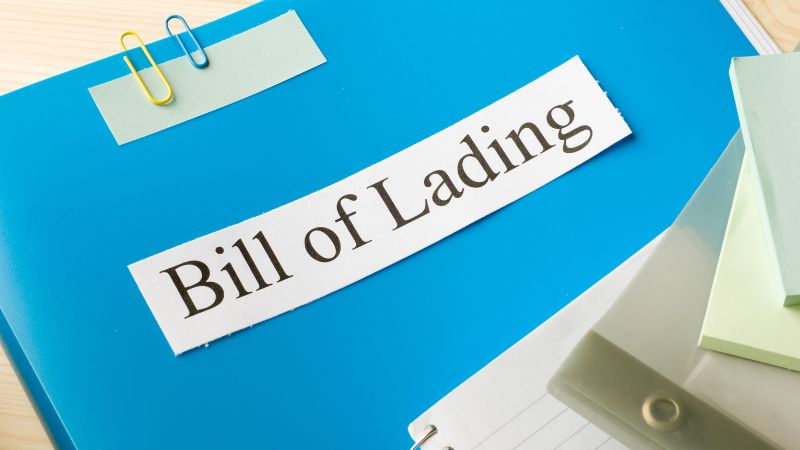When shipping goods, you need to understand the paperwork involved. A bill of lading is one of the most important documents in the shipping process.
Whether you’re new to shipping or looking to brush up on your knowledge, knowing these basic types will give you a solid foundation.
Definition of Bill of Lading
A bill of lading (BL) is a legal document issued by a carrier to a shipper that details the type, quantity, and destination of goods being transported.
It serves three main functions:
- Receipt of Goods
When you ship goods, this document proves you’ve transferred possession to the carrier. The carrier acknowledges receiving your cargo in the condition noted on the bill.
- Evidence of Shipping Contract
Your bill of lading also outlines the terms of your shipping agreement, including delivery instructions and liability limits. This creates a clear record of what both parties have agreed to.
- Establishes Ownership of Cargo
It acts as a title document. This means you can use it to claim your goods upon arrival or transfer ownership while items are in transit.
Information Included
Your bill of lading must contain specific details to be valid and useful. These details create clarity and prevent misunderstandings between all parties involved.
Essential information includes:
- Shipper’s and receiver’s complete contact information
- Detailed description of goods (type, quantity, dimensions)
- Special handling instructions or hazardous material notifications
- Freight classification and packaging type
- Pickup and delivery dates and locations
- Terms of payment and freight charges
The carrier will note the condition of your goods upon receipt. Any visible damage should be documented here to protect you from future claims disputes.
Different types of bills of lading (Original, Surrendered, Sea-Way) may require slightly different information, but these core elements remain consistent across all forms.
Types of Bill of Lading
Bills of lading are critical shipping documents that serve multiple purposes in cargo transportation. They act as receipts, contracts of carriage, and documents of title depending on the specific type being used.
Straight Bill of Lading
A straight bill of lading is a non-negotiable document that names a specific consignee. When you use this type, the goods can only be released to the person or company named on the document.
This type works best for transactions where you already know and trust the buyer. Carriers will deliver the cargo directly to the named recipient without requiring the original bill of lading at destination.
The straight bill of lading offers several advantages:
- Simpler delivery process – no original document needed at destination
- Faster cargo release – reduces delays at the destination port
- Lower risk of fraud – designated recipient is clearly specified
It’s commonly used for domestic shipments or when you’ve already received payment for the goods before shipping.
Order Bill of Lading
An order bill of lading is a negotiable document that provides more flexibility in cargo ownership transfer. It allows you to consign the shipment “to the order of” a named party.
The key feature here is transferability. You can endorse it to another party, making it perfect for transactions involving multiple parties or when payment hasn’t been secured before shipping.
When using an order bill of lading:
- The original document must be presented to claim the goods
- It provides security since goods won’t be released without it
- It can be used as collateral with banks for trade financing
This type offers excellent protection for sellers in international trade. It ensures you maintain control of your goods until payment has been made.
Bearer Bill of Lading
A bearer bill of lading is the most negotiable form. Unlike other types, it doesn’t name a specific consignee. Instead, whoever physically possesses the document can claim the shipment.
This creates a highly flexible but potentially risky document. You should use this type cautiously as it can be transferred simply by handing it over to someone else – no endorsement required.
Key points to remember:
- Highest negotiability – transfers with physical possession
- Greatest risk – can be used by anyone who holds it
- Limited tracking – ownership changes may not be documented
Due to the security concerns, bearer bills of lading have become less common in modern shipping. Many jurisdictions have placed restrictions on their use to prevent fraud and improve cargo security.
Comparing the 3 Types of Bill of Lading
Understanding the key differences between straight, order, and bearer bills of lading helps you choose the right document for your shipping needs. Each type offers distinct advantages and serves different business requirements depending on your shipping arrangements.
Straight Bill of Lading
- ✅ Benefits: Simple and secure, reducing risk of theft or fraud
- ✅ Streamlined delivery process with minimal documentation
- ❌ Risks: Lacks flexibility if your buyer situation changes
- ❌ Cannot be easily transferred if needed
Order Bill of Lading
- ✅ Benefits: Negotiable document that can be endorsed to new parties
- ✅ Supports letters of credit for international trade
- ❌ Risks: Requires careful handling to prevent unauthorized transfers
- ❌ More complex documentation process
Bearer Bill of Lading
- ✅ Benefits: Maximum flexibility for changing ownership
- ✅ Quick transfers without endorsement requirements
- ❌ Risks: Highest security concerns as possession equals ownership
- ❌ May not be accepted in some trade lanes due to security concerns
When choosing between these types, consider your relationship with the buyer, payment terms, and how likely ownership might change during shipment.
Common Challenges
Incorrect documentation is the biggest headache with bills of lading. Always double-check that all details match exactly with your commercial invoice and packing list. Even small discrepancies can cause customs delays.
Timing issues frequently arise with original bills of lading. Sometimes goods arrive at the destination before the documents, preventing release of the shipment. Consider using surrendered bills of lading when possible to avoid these delays.
Electronic bills of lading are gaining popularity but aren’t accepted everywhere. Check if your destination country and partners accept electronic formats before using them.
Watch out for “clean” versus “claused” bills. A claused bill indicates damage or problems with packaging. This can affect your payment, especially with letter of credit transactions.
Remember that freight forwarders use house bills of lading while carriers issue master bills. Keeping track of both documents is essential for consolidated shipments.
Frequently Asked Questions
What are the different kinds of bills of lading used in the shipping industry?
The most common types include Straight Bills of Lading, Order Bills of Lading, and Negotiable Bills of Lading.
Other important varieties include Inland Bills of Lading for domestic transport and Multimodal Bills of Lading for shipments using multiple transportation methods.
You might also encounter Ocean Bills of Lading for sea freight and Air Bills of Lading for air cargo.
How does the bill of lading process work, and who is responsible for issuing it?
The bill of lading process begins when you prepare your shipment. The carrier (shipping company) is responsible for issuing the bill of lading after inspecting and accepting your goods.
You’ll need to verify the information is correct before signing. Typically three original copies are produced – one each for the carrier, shipper, and consignee.
The document travels with the shipment or is sent ahead to the destination, where it must be presented to claim the goods.
Could you explain the difference between a House Bill of Lading (HBL) and an Ocean Bill of Lading (OBL)?
A House Bill of Lading (HBL) is issued by a freight forwarder to you as the shipper. It covers your specific shipment, even when consolidated with other shipments.
An Ocean Bill of Lading (OBL) is issued by the actual shipping line or carrier. It represents the contract between the vessel operator and the freight forwarder for all consolidated cargo.
You’ll usually deal with the HBL as a shipper, while the forwarder handles the OBL with the shipping line.

